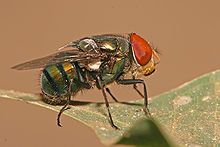芒果 (Mangifera indica) 是漆樹科芒果屬,原產印度東北與緬甸西北部,印度栽培已有4000年歷史,先後傳至東南亞、非洲、美洲、澳洲等地區,經品種改良,已遍及熱帶、亞熱帶地區,目前已成為是繼葡萄、柑橙、香蕉、蘋果之後的世界第五大栽培水果。
芒果於17世紀荷蘭治台時期引進台灣,在台灣稱為「檨仔」(suāinn-á) 、「土檨仔」或「檬果」,果小皮綠、肉少纖維多,但有特殊的風味。
1954年,農復會自美國佛羅里達州引進愛文 (Irwin)、海頓 (Haden)、肯特(Kent)、凱特 (Keitt) 等栽培種 (cultivar),經過7年試種馴化,選出最適合台灣的愛文種推廣。愛文芒皮紅肉黃,香氣濃,外表像紅蘋果一樣,所以當時又稱「蘋果檨」。
1962年原本栽種甘蔗等作物的台南玉井農民鄭罕池,嘗試改種愛文芒果,成為台灣最早種植愛文芒果的先驅。首批栽種的百棵芒果樹,三年後僅存四棵,但結出的芒果比土芒果碩大,果皮豔紅、果肉金黃,皮薄肉細、香甜可口。愛文上市後,大受消費者青睞,鄭先生很大方地將經驗傳授給其他果農,鄰近鄉鎮爭相種植,因玉井種植最廣,奠定「愛文芒果之鄉」的美名。
但在1960年代末期,台南地區芒果樹大量出現開花不結果的現象,原本授粉成功的果實可達三四百公克,但若沒授粉,就無法結果或只結如雞蛋大小的無子芒果。
曾任農復會秘書長的蔣彥士協調農政單位邀集果樹專家深入研究,經十餘年,依然未能解決。有農藝專家認為南部春季乾旱、水分不足,是造成芒果不結果的主因。台大園藝系林宗賢教授受命參與研究,以屏東枋山的芒果園進行試驗,結果加強灌水的果樹,無子芒果反而變多,推翻「水分不足造成芒果不結果」的假說。
林教授仔細觀察果園環境,發現由於果農大量栽種果樹,周遭原有次生林或草地劇減,昆蟲棲地消失,加上噴灑農藥及除草,昆蟲幾遭趕盡殺絕。缺少昆蟲授粉,芒果樹即使開再多花也不太會結果。
1987年,有一回林宗賢在玉井調查時,看到鄉間居民將酬神建醮儀式過後發臭的豬頭丟棄在芒果樹下,吸引了大群俗稱金蒼蠅的麗蠅 (blow fly),林宗賢注意到這些飛舞的蒼蠅附近的芒果樹都結實累累,不禁聯想,這可能是解決「開花不結果」的救星。
於是林宗賢說服果農吳清進配合實驗,1988年芒果開花期間,在每八棵芒果樹中間放一堆發臭雜魚或家禽內臟,麗蠅嗅覺非常靈敏,果園一有腐肉味,它們就會聞風而至,順帶也為芒果授粉。幾個月後芒果採收,每公頃產量達為過去的許多倍,困擾十多年的芒果開花不結果問題,終於找到解決方法。然因衛生形象的考量,農委會建議不要發表,但果農間口耳相傳,在芒果開花期間誘引麗蠅,現已成為臺灣果園量產愛文芒果的秘密武器。
今天我們有香甜可口又平價的愛文芒果可吃,應當感謝玉井農民鄭罕池的無私,台大林宗賢教授發現的秘密武器,以及麗蠅。
By the end of the 1960s, a large number of Irwin mango trees in Tainan area were experiencing an alarming phenomenon—they would flower but not bear fruit. A pollinated Irwin mango would weigh between 300 and 400 grams. But many mangoes weren’t being pollinated, resulting in a majority of trees without mangoes.
Taiwan’s Council of Agriculture formed a task force to solve the issue plaguing fruit farmers. However, more than ten years past, the farming predicament still remained unsolved.
One day in 1987, Professor Lin Tzong-Shyan saw a reeking pig head under a mango tree that had attracted hordes of blow flies, and the sounds of the large-headed flies could be heard buzzing around several mango trees nearby. Noticing an abundance of mangoes hanging from these trees, Lin Tzong-Shyan connected the dots. Could these blow flies be the savior sent to solve the issue of mango trees not bearing fruit?
During the mango flowering season of 1988, Lin Tzong-Shyan convinced a farmer to implement a grid shaped pattern in which the center area of every eight mango trees would have a pile of rotten fish or poultry viscera to attract blow flies. A few months later, the farmer had a bountiful harvest of mangoes. The output was several times higher than previous years. The problem of mangoes flowering but not bearing fruit, which had confounded Taiwan’s Council of Agriculture for so long, had finally been so creatively solved. Taiwan’s mango output skyrocketed thereafter.
(Jerome Su, August 14, 2018)

